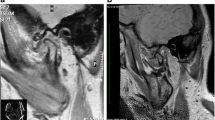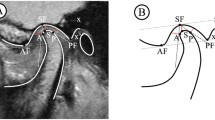Abstract
Objectives
This study aims to assess the disk morphology and the condyle position in subjects with temporomandibular (TMJ) disk displacements on sagittal and coronal magnetic resonance imaging (MRI).
Materials and methods
Seventy-four TMJs (from 37 patients) with positive clinical TMD symptoms according to the RDC/TMD axis I protocol were evaluated by 1.5 T MRI. Disk position, disk morphology, sagittal and coronal condyle position, joint effusion, joint space, and coronal condyle angulation were evaluated. Multivariate logistic regression was used to explore the relationship between disk displacement and MRI variables.
Results
Disk displacement with reduction (DDR) was found in 36.48 % and without reduction (DDwR), in 21.62 % of the joints. Disk displacement was anterior in 35.1 %, anterior-medial in 13.5 %, and anterior-lateral in 9.45 % of cases. The thickened posterior band (94.48 OR, p = 0.001) and the posterior condyle position (4.57 OR, p = 0.03) were more likely found on sagittal MRI in disk displacements. On coronal slices, the disk displacement was significantly associated with the distance from the most medial condyle point to the midplane (p < 0.05).
Conclusions
Disk displacement is associated with changes of disk shape, disk dimension, and condyle position on sagittal MRI. A significant variation of the distance from the most medial condyle point to the midplane in disk displacement was found on coronal MRI.
Clinical relevance
Our study highlights the existence of changes on coronal MRI in TMD patients which should be assessed for better understanding of the clinical evolution of temporomandibular disorders.




Similar content being viewed by others
References
Gahleitner A, Watzek G, Imhof H (2003) Dental CT: imaging technique, anatomy, and pathologic conditions of the jaws. Eur Radiol 13:366–410
Tasaki MM, Westesson PL (1993) Temporomandibular joint: diagnostic accuracy with sagittal and coronal MR imaging. Radiology 186:723–729
Boeddinghaus R, Whyte A (2008) Current concepts in maxillofacial imaging. Eur J Radiol 66:396–418
Guler N, Yatmaz PI, Ataoglu H, Emlik D, Uckan S (2003) Temporomandibular internal derangement: correlation of MRI findings with clinical symptoms of pain and joint sounds in patients with bruxing behaviour. Dentomaxillofac Radiol 32:304–310
Abolmaali ND, Schmitt J, Schwarz W, Toll DE, Hinterwimmer S, Vogl TJ (2004) Visualization of the articular disk of the temporomandibular joint in near-real-time MRI: feasibility study. Eur Radiol 14:1889–1894
Tasali N, Cubuk R, Aricak M, Ozarar M, Saydam B, Nur H, Tuncbilek N (2012) Temporomandibular joint (TMJ) pain revisited with dynamic contrast-enhanced magnetic resonance imaging (DCE-MRI). Eur J Radiol 81:603–608
Farina D, Bodin C, Gandolfi S, De Gasperi W, Borghesi A, Maroldi R (2009) TMJ disorders and pain: assessment by contrast-enhanced MRI. Eur J Radiol 70:25–30
Park JW, Song HH, Roh HS, Kim YK, Lee JY (2012) Correlation between clinical diagnosis based on RDC/TMD and MRI findings of TMJ internal derangement. Int J Oral Maxillofac Surg 41:103–108
Larheim TA, Westesson P, Sano T (2001) Temporomandibular joint disk displacement: comparison in asymptomatic volunteers and patients. Radiology 218:428–432
Schmitter M, Kress B, Ludwig C, Koob A, Gabbert O, Rammelsberg P (2005) Temporomandibular joint disk position assessed at coronal MR imaging in asymptomatic volunteers. Radiology 236(2):559–564
Brooks S, Westesson PL (1993) Temporomandibular joint: value of coronal MR images. Radiology 188:317–321
Dworkin SF, LeResche L (1992) Research diagnostic criteria for temporomandibular disorders: review, criteria, examinations and specifications, critique. J Craniomandib Disord 6:301–355
Manfredini D, Guarda-Nardini L (2008) Agreement between Research Diagnostic Criteria for Temporomandibular Disorders and magnetic resonance diagnoses of temporomandibular disk displacement in a patient population. Int J Oral Maxillofac Surg 37:612–616
Orhan K, Nishiyama H, Tadashi S, Murakami S, Furukawa S (2006) Comparison of altered signal intensity, position, and morphology of the TMJ disk in MR images corrected for variations in surface coil sensitivity. Oral Surg Oral Med Oral Pathol Oral Radiol Endod 101:515–522
Robinson de Senna B, Marques LS, França JP, Ramos-Jorge ML, Pereira LJ (2009) Condyle-disk-fossa position and relationship to clinical signs and symptoms of temporomandibular disorders in women. Oral Surg Oral Med Oral Pathol Oral Radiol Endod 108:e117–124
Kundel HL, Polansky M (2003) Measurement of observer agreement. Radiology 228:303–308
R Development Core Team. R (2004) A language and environment for statistical computing, 4th edn. R Foundation for Statistical Computing, Vienna, http://www.R-project.org
Sxener S, Akgunlu F (2004) MRI characteristics of anterior disk displacement with and without reduction. Dentomaxillofac Radiol 33:245–252
Incesu L, Taskaya-Yilmaz N, Ogutcen-Toller M, Uzun E (2004) Relationship of condylar position to disk position and morphology. Eur J Radiol 51:269–273
Heffez L, Jordan S (1989) A classification of temporomandibular joint disk morphology. Oral Surg Oral Med Oral Pathol 67:11–19
Miller TL, Katzberg RW, Tallents RH, Bessette RW, Hayakawa K (1985) Temporomandibular joint clicking with nonreducing anterior displacement of the meniscus. Radiology 154:121–124
Taşkaya-Yýlmaz N, Oğütcen-Toller M (2002) Clinical correlation of MRI findings of internal derangements of the temporomandibular joints. Br J Oral Maxillofac Surg 40:317–321
Wang M, Cao H, Ge Y, Widmalm SE (2009) Magnetic resonance imaging on TMJ disk thickness in TMD patients: a pilot study. J Prosthet Dent 102:89–93
Rammelsberg P, Jäger L, Duc JM (2000) Magnetic resonance imaging-based joint space measurements in temporomandibular joints with disk displacements and in controls. Oral Surg Oral Med Oral Pathol Oral Radiol Endod 90:240–248
Pereira LJ, Gavião M, Bonjardim LR, Castelo PM (2007) Ultrasound and tomographic evaluation of temporomandibular joints in adolescents with and without signs and symptoms of temporomandibular disorders: a pilot study. Dentomaxillofac Radiol 36:402–408
Roh HS, Kim W, Kim YK, Lee JY (2012) Relationships between disk displacement, joint effusion, and degenerative changes of the TMJ in TMD patients based on MRI findings. J Craniomaxillofac Surg 40:283–286
Manfredini D, Basso D, Arboretti R, Guarda-Nardini L (2009) Association between magnetic resonance signs of temporomandibular joint effusion and disk displacement. Oral Surg Oral Med Oral Pathol Oral Radiol Endod 107:266–271
Larheim TA, Westesson PL, Sano T (2001) MR grading of temporomandibular joint fluid: association with disk displacement categories, condyle marrow abnormalities and pain. Int J Oral Maxillofac Surg 30:104–112
Huh JK, Kim HG, Ko JY (2003) Magnetic resonance imaging of temporomandibular joint synovial fluid collection and disk morphology. Oral Surg Oral Med Oral Pathol Oral Radiol Endod 95:665–671
Acknowledgments
This study is supported by funding from a POSDRU/107/1.5/S/78702 project from the University of Medicine and Pharmacy “Iuliu Haţieganu” Cluj-Napoca, Romania.
Conflict of interest
The authors declare that they have no conflicts of interests.
Author information
Authors and Affiliations
Corresponding author
Rights and permissions
About this article
Cite this article
Almăşan, O.C., Hedeşiu, M., Băciuţ, G. et al. Disk and joint morphology variations on coronal and sagittal MRI in temporomandibular joint disorders. Clin Oral Invest 17, 1243–1250 (2013). https://doi.org/10.1007/s00784-012-0803-4
Received:
Accepted:
Published:
Issue Date:
DOI: https://doi.org/10.1007/s00784-012-0803-4




